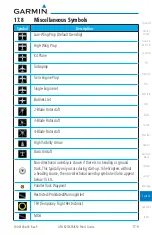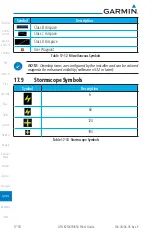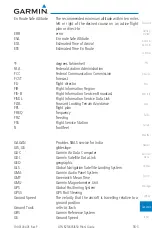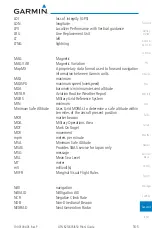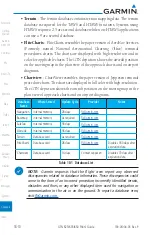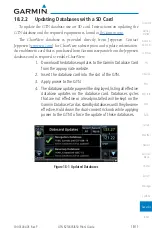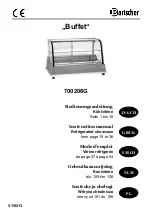
18-9
190-01004-03 Rev. P
GTN 625/635/650 Pilot’s Guide
Appendix
18.2
Database Information and Updates
The GTN uses several databases to provide up-to-date aviation information.
GTN databases can be updated by the pilot using an SD card or Flight Stream
510 wireless database card. The GTN can also synchronize databases in the
cockpit with other displays using Database SYNC and Chart Streaming.
Information about the installed and standby databases can be viewed on the
System Status page. Database SYNC and Chart Streaming can be configured in
the menu on the System Status page.
The database card should not be removed except to update the databases
stored on the card. For basic flight operations, a database card is required for
database storage. The database cards cannot be shared between units.
18.2.1 GTN Databases
•
Navigation
- The navigation database contains information for waypoints
and airports, such as procedures, runways, airways, airspaces, frequencies,
and visual reporting points. For helicopter applications, a navigation
database that includes additional heliports is available.
•
Basemap
- The Basemap database contains land and water data, such as
roads, boundaries, rivers, and lakes.
•
SafeTaxi
- The SafeTaxi database contains detailed airport diagrams
for selected airports. These diagrams aid in following ground control
instructions by displaying the aircraft position on the map in relation to
taxiways, ramps, runways, terminals, and services.
•
Obstacles
- The obstacle database contains data for obstacles, such as
towers, that pose a potential hazard to aircraft. Obstacles 200 feet and
higher are included in the fixed-wing obstacle database. The rotorcraft
database includes all reported obstacles regardless of height. It is important
to note that not all obstacles are necessarily charted and therefore may not
be contained in the obstacle database. Several obstacle database options
are available. Obstacle databases created for GTN software v5.10 or later
include all power lines or only Hazardous Obstacle Transmission (HOT)
lines depending on the type of obstacle database installed. HOT lines are
those power lines that are co-located with other FAA-identified obstacles.
The obstacle database is required for the TAWS and HTAWS functions.
Summary of Contents for GTN 625
Page 608: ...This page intentionally left blank ...
Page 609: ......
Page 610: ...190 01004 03 Rev P ...





